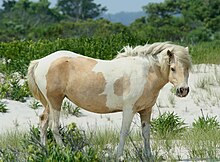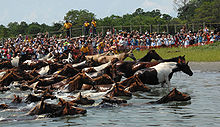
Chincoteague pony
| |
| Other names | Assateague horse |
|---|---|
| Country of origin | United States |
The Chincoteague Pony, also known as the Assateague horse, is a breed of pony that developed and lives in a feral condition on Assateague Island in the United States states of Virginia and Maryland. The breed was made famous by the Misty of Chincoteagueseries written by Marguerite Henry starting in 1947. While phenotypically horse-like, they are commonly called "ponies". This is due in part to their smaller stature, created by the poor habitat on Assateague Island. Variation is found in their physical characteristics due to blood from different breeds being introduced at various points in their history. They can be any solid color, and are often found in pinto patterns, which are a favorite with breed enthusiasts. Island Chincoteagues live on a diet of salt marsh plants and brush. This poor-quality and often scarce food combined with uncontrolled inbreeding created a propensity for conformation faults in the Chincoteague before outside blood was added beginning in the early 20th century.
Several legends are told regarding the origins of the Chincoteague, the most popular holds that they descend from survivors of wrecked Spanish galleons off the Virginia coast. It is more likely that they descend from stock released on the island by 17th-century colonists looking to escape livestock laws and taxes on the mainland. In 1835, the practice of pony penning began, with local residents rounding up ponies and removing some of them to the mainland. In 1924 the first official "Pony Penning Day" was held by the Chincoteague Volunteer Fire Company, where ponies were auctioned as a way to raise money for fire equipment. The annual event has continued in the same fashion almost uninterrupted to the present day.
Although popularly known as Chincoteague ponies, the feral ponies actually live on Assateague Island. Although the entire Island is owned by the federal government, Assateague is split by a fence at the Maryland/Virginia state line, with a herd of around 150 ponies living on each side of the fence. The herds live on land managed by two different federal agencies with very different management strategies. Ponies from the Maryland herd, referred to in literature of the National Park Serviceas Assateague horses, live within Assateague Island National Seashore. They are generally treated as wild animals, given no more or less assistance than other species on the island, other than to be treated with contraceptives to prevent overpopulation. Conversely, the Virginia herd, referred to as Chincoteague ponies, lives within the Chincoteague National Wildlife Refuge but is owned by the Chincoteague Volunteer Fire Company. The Virginia ponies are treated to twice yearly veterinary inspections, which prepare them for life among the general equine population if they are sold at auction. While only around 300 ponies live on Assateague Island, around 1,000 more live off-island, having been purchased or bred by private breeders.
...
Legend states that Chincoteague ponies descend from Spanish horses shipwrecked off the Virginia coast on their way to Peru in the 16th century.[4] Another story holds that they descend from horses left on the island by pirates. Both of these theories are unlikely, as no documentation has been found to show horses inhabiting the island this early, and no mention of horses already existing on the island was made by colonists on either the mainland or the island in the mid-to-late 1600s.[5] Evidence points, however, to their ancestors actually being horses brought to the islands in the 17th century by mainland farmers. Livestock on the islands were not subject to taxes or fencing laws, and so many animals, including hogs, sheep, cattle and horses, were brought to the islands.[2] While the National Park Service holds to the theory that the horses were brought to the island in the 17th century,[6] the Chincoteague Volunteer Fire Company, which owns the ponies on the Virginia side of Assateague,[6] argues that the Spanish shipwreck theory is correct. They argue that horses were too valuable in the 17th century to have been left to run wild on the island, and claim that there are two sunken Spanish galleons off the Virginia coast in support of their theory.[1] The National Chincoteague Pony Association also promotes the shipwreck theory.[7] In the early 1900s, they were described as having been on the islands since well before the American Revolution, and were described at that time as "very diminutive, but many of them are of perfect symmetry and extraordinary powers of action and endurance." In the early 1800s, Virginia governor Henry A. Wise released what one author called the "earliest printed testimony" on the Chincoteague.[8]
During the 1920s, before the herds were managed by various agencies, many conformation faults were found—the effects of uncontrolled inbreeding. Misshapen legs, narrow chests, poor bone and a lack of substance plagued the breed, with many stunted animals not growing above 12 hands (48 inches, 122 cm). This was partially due to the limited and poor-quality feed found on the islands, although this harsh habitat also allowed only the hardiest and most adaptable ponies to survive. Welsh and Shetland pony blood was added to upgrade the stock, and horses with pinto coloring were introduced to give the herd its common distinctive patterns and contribute to the more horse-like phenotype of the breed.[4] Twenty Mustangs owned by the Bureau of Land Management were introduced in 1939. Arabian blood was added in the hopes of adding refinement and height to the breed, as well as increasing the length of their legs. Arabian stallions were used at two different points within the breed history: one was released with the herd, but did not survive, while another was bred to mares that had been removed from the island for breeding and then returned once in foal.[2] The Chincoteague pony has a similar history to the Shackleford Banker Horse, which comes from the Shackleford Banks off the coast of North Carolina. However, the Shackleford is a more isolated population, with no outside blood added to the island herd.[9]
The island itself has also undergone change. At one time, the island was connected to the lowest point of Fenwick Island. In August 1933, a hurricane created an inlet south of Ocean City, Maryland,[10] separating the two landforms. After the storm, between 1933 and 1935, a permanent system of artificial jetties was built to preserve the inlet as a navigation channel.[11] As a result of the jetties disrupting sand movement in the area, the island has drifted considerably westward, and the two landmasses are now over 1 kilometer (0.62 mi) apart.[10]
Pony penning[edit]
In 1835, the first written description of "pony penning" appeared, though the practice of rounding up livestock on the island existed for many years before that. Initially, unclaimed animals were marked for ownership by groups of settlers. By 1885, the event had become a festival day, and two days of horse and sheep roundups were held on Assateague and Chincoteague Islands. While the sheep population diminished over time, the pony population grew.[2] In 1909, the last Wednesday and Thursday of July were designated as the annual days for pony penning, still taking place on both Assateague and Chincoteague Islands. However, in the early 1920s, much of Assateague Island was purchased by a wealthy farmer, forcing many settlers to move to Chincoteague Island and necessitating a change in the pony penning format. By 1923, all parts of pony penning except for the actual roundup had moved to Chincoteague Island, with the ponies being transported by truck for the first two years before the annual swim was begun.[12] By the early 1900s, Chincoteague Island had been established as a tourism and sport haven, and in 1922, a causeway was completed that connected the island to the Virginia mainland. After a pair of fires ravaged Chincoteague Island that same year, the Chincoteague Volunteer Fire Company was established. In 1924, the first official Pony Penning Day was held, where the foals were auctioned at $25–50 each to raise money for fire equipment. Pony Penning Day has been held annually ever since, with the exception of 1942 and 1943.[2]
Currently as many as 50,000 visitors gather on the last Wednesday in July to watch mounted riders bring the Virginia herd from Assateague and swim them across the channel to Chincoteague Island. The swim takes five-ten minutes, with both the rider and the observers on hand to assist horses, especially foals, who may have a hard time with the crossing.[2]Before the swim, the herd is evaluated and mares in the late stages of pregnancy and those with very young foals are removed from the herd to be trailered between the islands. During the swim, some lactating mares become affected with hypocalcemia, which is treated by on-site veterinarians.[13] Larger foals are auctioned the next day and the majority of the herd, including any young foals, are returned to Assateague on Friday.[2] As of 2015, the highest price paid for a pony was $25,000 and the lowest price was $500. Some ponies are purchased under "buy back" conditions, where the bidder donates the money to the fire department but allows the pony to be released back onto Assateague Island.
...
Books
In 1947, Marguerite Henry released the children's book Misty of Chincoteague, the first in a series of novels that made the Chincoteague breed internationally famous. The real Misty was foaled on Chincoteague Island in 1946, and was purchased as a weanling by Henry.[22] In 1961, the publicity was increased even more when the film Misty was made, based on the book.[4] The publicity generated by the books assisted the Chincoteague Fire Department and the breed in remaining viable into the 21st century. While fictionalized, the books were based on a real horse and ranch on Chincoteague Island, and the Misty of Chincoteague Foundation was established in 1990, to preserve the Beebe Ranch and establish a museum with memorabilia from the series.[2] Model horse company Breyer Animal Creations has created models of Misty and five of her descendants. As of 2001, there were around 40 surviving descendants of Misty worldwide.[1]




No comments:
Post a Comment